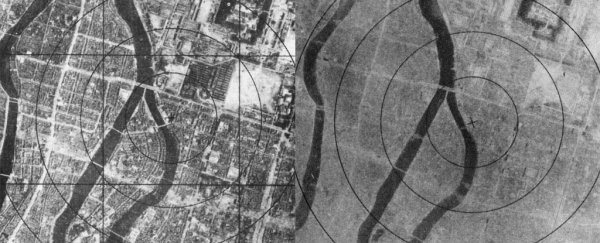What happened to Hiroshima? Everybody thinks they know the answer, and yet, strangely, nobody does.
History tells us Hiroshima was destroyed by the first atomic bomb deployed in war on 6 August 1945. But what happened to the actual city when it was consumed in its awful, unforgettable fire? Where did Hiroshima go?
We might finally have an answer to this terrible question.
In 2015, retired geologist and marine ecologist Mario Wannier was examining samples of beach sand collected from Japan's Motoujina Peninsula, just 6 kilometres (3.7 miles) south of Hiroshima's hypocentre, or ground zero.
Primarily, Wannier and fellow researcher Marc de Urreiztieta were looking for traces of microscopic organisms called foraminifera in the sediment, but that's not all they found.
"There was something else," Wannier says.
"It's so obvious when you look at the sample. You couldn't miss these extraneous particles. They are generally aerodynamic, glassy, rounded."
 (Wannier et al., Anthropocene, 2019)
(Wannier et al., Anthropocene, 2019)
These strange glass spherule particles – some of which resemble the kind of glassy debris ejected into the atmosphere during meteorite impacts – are estimated to constitute up to 2.5 percent of all the sand in the beaches around Hiroshima.
Wannier ended up collecting some 10,000 samples of this unusual grit, which were examined by researchers at the Berkeley Lab and UC Berkeley, using electron microscopy and X-ray analysis.
The findings, reported in a new paper, suggest the only "coherent explanation" for the glass particles is that they are the first reported evidence of fallout debris from a nuclear explosion in an urban environment.
"In the surprise of finding these particles, the big question for me was: You have a city, and a minute later you have no city," says Wannier.
"There was the question of: 'Where is the city – where is the material?'"
According to the the team's analysis, the raw material that once made up the city of Hiroshima – its buildings, steel, and concrete – were swept up in the nuclear blast and fused in incredible heat, before cooling, and falling down to Earth in a rain of fine glassy shards.
 (Wannier et al., Anthropocene, 2019)
(Wannier et al., Anthropocene, 2019)
These forms – called the Motoujina Fallout Debris (MFD) – have been nicknamed 'Hiroshimaites', after glassy analogues called trinitites, previously discovered at the Trinity nuclear test site in New Mexico.
"The ground material is volatilised and moved into the cloud, where the high temperature changes the physical condition," says Wannier.
"There are a lot of interactions between particles. There are lots of little spheres that collide, and you get this agglomeration."
Of course, the researchers' fallout hypothesis can't be easily proven, but the team says it's the only logical explanation for the range of evidence they've detected.
That evidence includes the unique microstructure of the particles, the extreme heat that would have been necessary to form them, and the sheer volume of spherule sediment (estimated to weigh thousands of tonnes) mixed in with the regular sand along the beaches of Hiroshima Bay.
What's amazing is that nobody has ever discovered this before in the decades since WWII, especially since Japanese scientists were analysing soil and sand for radioactivity within days of the destructive blast in 1945.
In light of everything going on at the time, perhaps we shouldn't be too surprised that no attention was given to a physical description of those samples, the researchers suggest.
"Following the nuclear explosions at both Hiroshima and shortly after at Nagasaki, and the devastation at a scale not seen before, the rescuers, doctors, and scientists focused their efforts on curing human suffering and measuring the effects of atomic radiation," the team writes.
"Somehow, in this situation of extreme emergency, the question of the whereabouts of the vanished urban built structures was not addressed."
There remain many unanswered questions, not the least of which is whether these strange particles still exhibit traces of radioactivity at the submicroscopic scale – or how they might compare to soil samples extracted from Hiroshima's ground zero.
Future research will have a chance to examine those questions in time, but for now, a long outstanding unknown arising from one of humankind's darkest hours looks to finally be resolved.
"It is a trove to have discovered these particles," says Wannier. "It is an incredible story."
The findings are reported in Anthropocene.
